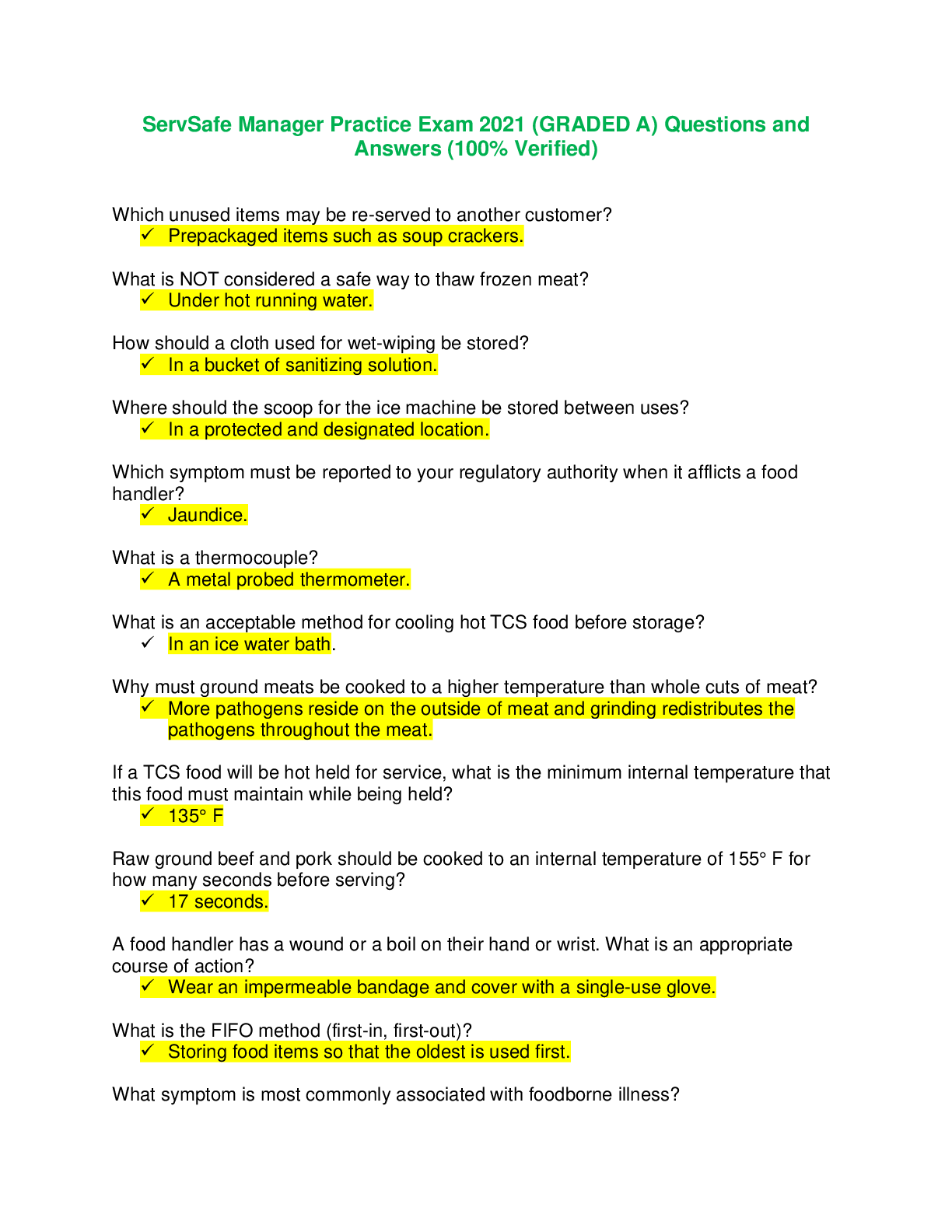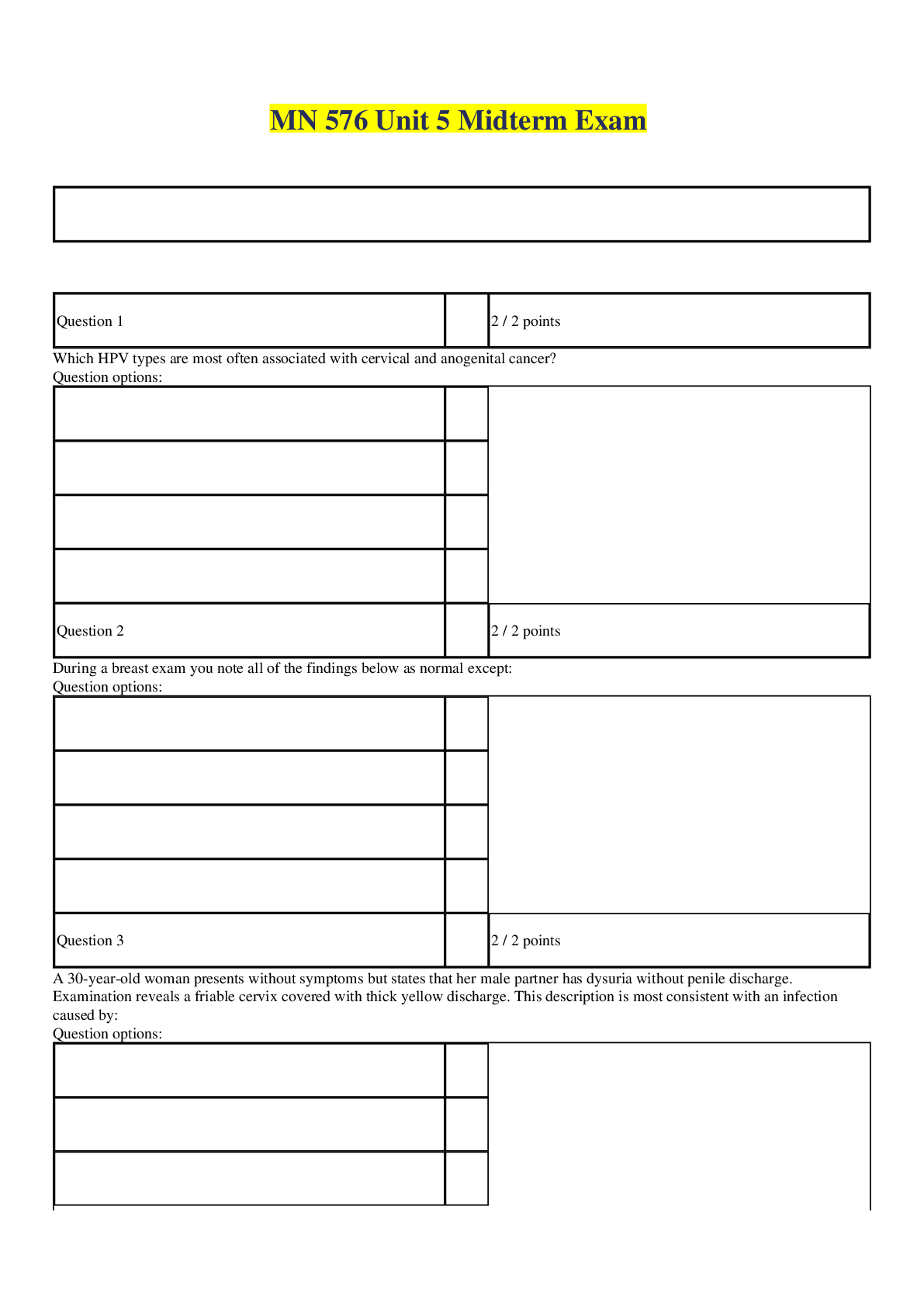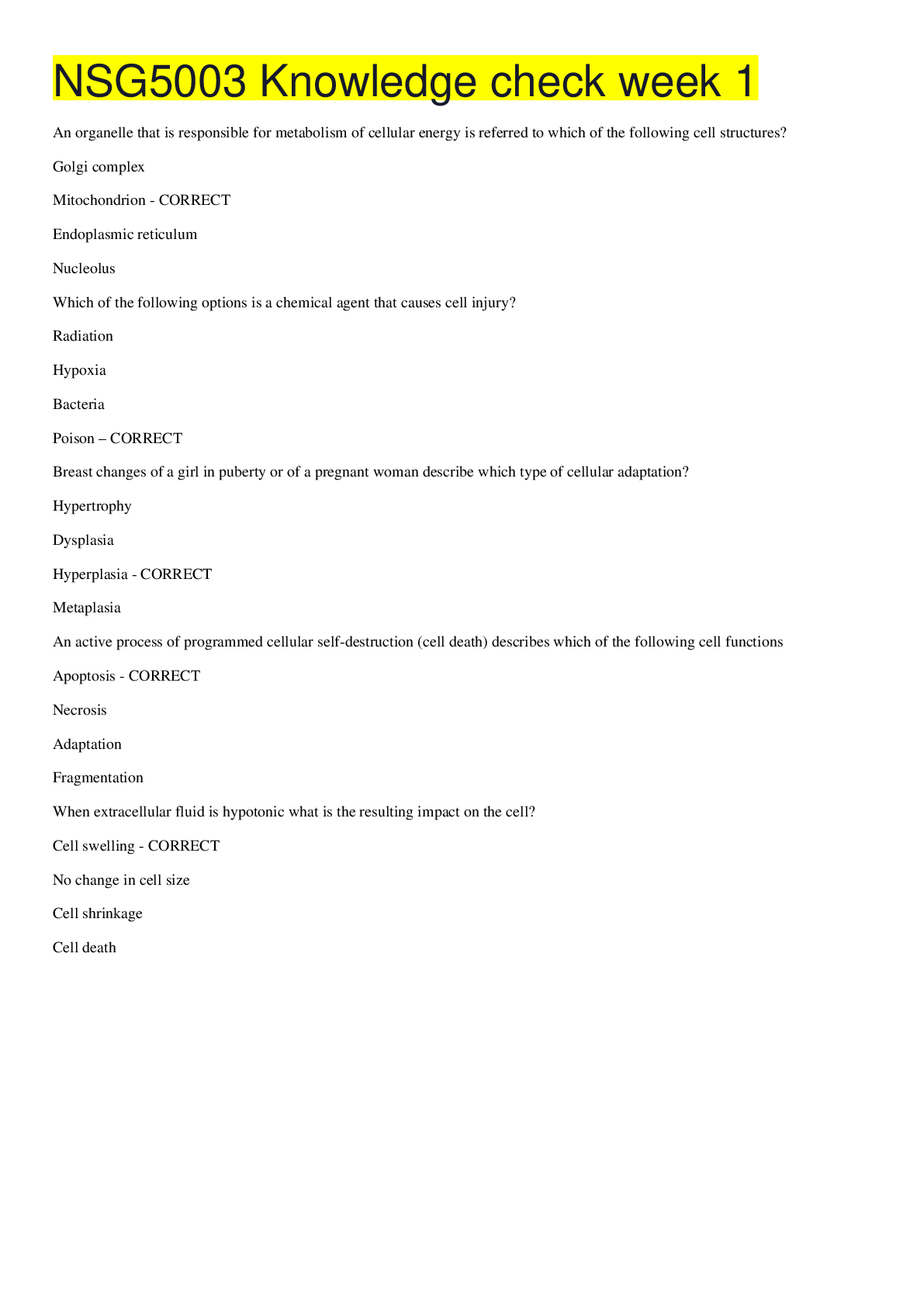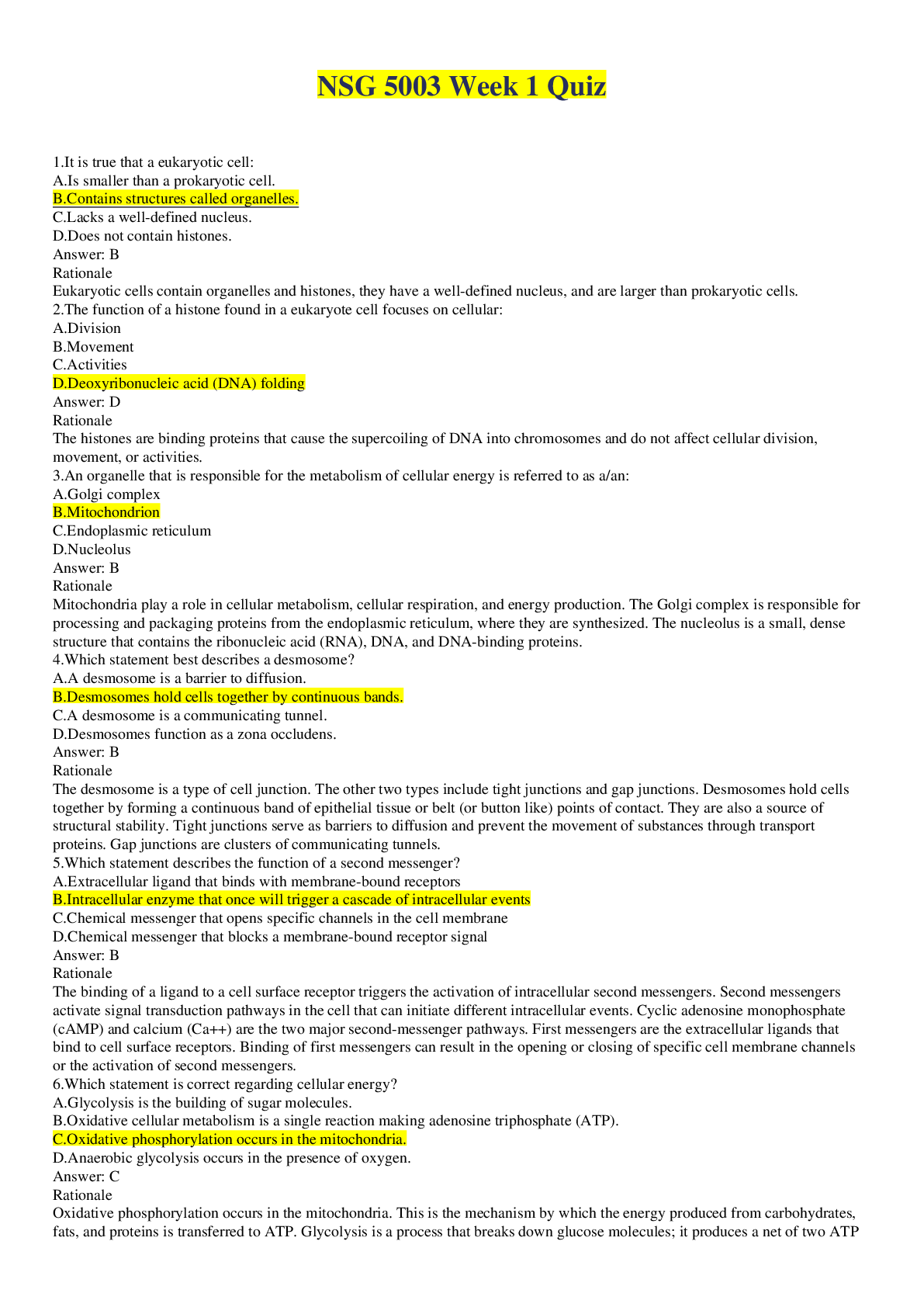*NURSING > EXAM > NURSING OB MOTHER BABY EXAM 3 | 100% Verified Questions and Answer Solutions | Download To Score An (All)
NURSING OB MOTHER BABY EXAM 3 | 100% Verified Questions and Answer Solutions | Download To Score An A
Document Content and Description Below
1. A 25-year-old gravida 2, para 2-0-0-2 gave birth 4 hours ago to a 9-pound, 7-ounce boy after augmentation of labor with Pitocin. She puts on her call light and asks for her nurse right away, statin... g, Im bleeding a lot. The most likely cause of postpartum hemorrhage in this woman is: Uterine atony. 2. On examining a woman who gave birth 5 hours ago, the nurse finds that the woman has completely saturated a perineal pad within 15 minutes. The nurses first action is to: Massage the womans fundus. 3. The nurse observes that a 15-year-old mother seems to ignore her newborn. A strategy that the nurse can use to facilitate mother-infant attachment in this mother is to: Show the mother how the infant initiates interaction and pays attention to her. 4. In the recovery room, if a woman is asked either to raise her legs (knees extended) off the bed or to flex her knees, place her feet flat on the bed, and raise her buttocks well off the bed, most likely she is being tested to see whether she: Has recovered from epidural or spinal anesthesia. 5. When caring for a newly delivered woman, the nurse is aware that the best measure to prevent abdominal distention after a cesarean birth is: Early and frequent ambulation. 6. During a phone follow-up conversation with a woman who is 4 days postpartum, the woman tells the nurse, I dont know whats wrong. I love my son, but I feel so let down. I seem to cry for no reason! The nurse would recognize that the woman is experiencing: Postpartum (PP) blues. 7. New parents express concern that, because of the mothers emergency cesarean birth under general anesthesia, they did not have the opportunity to hold and bond with their daughter immediately after her birth. The nurses response should convey to the parents that: Attachment, or bonding, is a process that occurs over time and does not require early contact. 8. During a phone follow-up conversation with a woman who is 4 days postpartum, the woman tells the nurse, I dont know whats wrong. I love my son, but I feel so let down. I seem to cry for no reason! The nurse would recognize that the woman is experiencing: Taking-in. 9. A man calls the nurses station and states that his wife, who delivered 2 days ago, is happy one minute and crying the next. The man says, She was never like this before the baby was born. The nurses initial response could be to: Reassure him that this behavior is normal. 10. A primary nursing responsibility when caring for a woman experiencing an obstetric hemorrhage associated with uterine atony is to: Perform fundal massage. 11. The perinatal nurse assisting with establishing lactation is aware that acute mastitis can be minimized by: Using proper breastfeeding techniques. 12. What infection is contracted mostly by first-time mothers who are breastfeeding? Mastitis Mastitis is infection in a breast, usually confined to a milk duct. Most women who suffer this are primiparas who are breastfeeding. 13. When a woman is diagnosed with postpartum depression (PPD) with psychotic features, one of the main concerns is that she may: Harm her infant. 14. To provide adequate postpartum care, the nurse should be aware that postpartum depression (PPD)without psychotic features: Is distinguished by irritability, severe anxiety, and panic attacks. 15. To provide adequate postpartum care, the nurse should be aware that postpartum depression (PPD)with psychotic features: May include bipolar disorder (formerly called manic depression). With shortened hospital stays, new mothers are often discharged before they begin to experience symptoms of the baby blues or postpartum depression. As part of the discharge teaching, the nurse can prepare the mother for this adjustment to her new role by instructing her regarding self-care activities to help prevent postpartum depression. The most accurate statement as related to these activities is to: Realize that this is a common occurrence that affects many women. 16. Which options for saying goodbye would the nurse want to discuss with a woman who is diagnosed with having a stillborn girl? When your baby is born, would you like to see and hold her? 17. During the initial acute distress phase of grieving, parents still must make unexpected and unwanted decisions about funeral arrangements and even naming the baby. The nurses role should be to: Make sure the parents themselves approve the final decisions. 18. Complicated bereavement: Is an extremely intense grief reaction that persists for a long time. 19. A woman delivered a 9-lb, 10-oz baby 1 hour ago. When you arrive to perform her 15-minute assessment, she tells you that she feels all wet underneath. You discover that both pads are completely saturated and that she is lying in a 6-inch-diameter puddle of blood. What is your first action? Assess the fundus for firmness. 20. If nonsurgical treatment for late postpartum hemorrhage is ineffective, which surgical procedure is appropriate to correct the cause of this condition? D&C 21. Anxiety disorders are the most common mental disorders that affect women. While providing care to the maternity patient, the nurse should be aware that one of these disorders is likely to be triggered by the process of labor and birth. This disorder is: Post-traumatic stress disorder (PTSD). 22. A woman gave birth to a healthy 7-pound, 13-ounce infant girl. The nurse suggests that the woman place the infant to her breast within 15 minutes after birth. The nurse knows that breastfeeding is effective during the first 30 minutes after birth because this is the: First period of reactivity. 23. The parents of a newborn ask the nurse how much the newborn can see. The parents specifically want to know what type of visual stimuli they should provide for their newborn. The nurse responds to the parents by Infants can track their parents eyes and distinguish patterns; they prefer complex patterns. 24. ?? A client is warm and asks for a fan in her room for her comfort. The nurse enters the room to assess the mother and her infant and finds the infant unwrapped in his crib with the fan blowing over him on high. The nurse instructs the mother that the fan should not be directed toward the newborn and the newborn should be wrapped in a blanket. The mother asks why. The nurses best response is: Your baby may lose heat by convection, which means that he will lose heat from his body to the cooler ambient air. You should keep him wrapped and prevent cool air from blowing on him. 25. A first-time father is changing the diaper of his 1-day-old daughter. He asks the nurse, What is this black, sticky stuff in her diaper? The nurses best response is: Thats meconium, which is your babys first stool. Its normal. A meconium stool can be differentiated from a transitional stool in the newborn because the meconium stool is: Passed in the first 12 hours of life. 26. Which statement describing physiologic jaundice is incorrect? Breastfed babies have a lower incidence of jaundice. A first-time dad is concerned that his 3-day-old daughters skin looks yellow. In the nurses explanation of physiologic jaundice, what fact should be included? The bilirubin levels of physiologic jaundice peak between the second and fourth days of life. 27. Cardiovascular changes that cause the foramen ovale to close at birth are a direct result of: Increased pressure in the left atrium. 28. In administering vitamin K to the infant shortly after birth, the nurse understands that vitamin K is: Not initially synthesized because of a sterile bowel at birth. 29. Which newborn reflex is elicited by stroking the lateral sole of the infants foot from the heel to the ball of the foot? Babinski 30. A new father wants to know what medication was put into his infants eyes and why it is needed. The nurse explains to the father that the purpose of the Ilotycin ophthalmic ointment is to: Prevent gonorrheal and chlamydial infection of the infants eyes potentially acquired from the birth canal. A primigravida has just delivered a healthy infant girl. The nurse is about to administer erythromycin Erythromycin is given prophylactically to prevent a gonorrheal infection. 31. The nurse is performing a gestational age and physical assessment on the newborn. The infant appears to have an excessive amount of saliva. The nurse recognizes that this finding: May indicate that the infant has a tracheoesophageal fistula or esophageal atresia. 32. As part of Standard Precautions, nurses wear gloves when handling the newborn. The chief reason is: To protect the nurse from contamination by the newborn. 33. The nurses initial action when caring for an infant with a slightly decreased temperature is to: Place a cap on the infants head and have the mother perform kangaroo care. 34. An Apgar score of 10 at 1 minute after birth would indicate a(n): Infant having no difficulty adjusting to extrauterine life but who should be assessed again at 5 minutes after birth. 35. Nursing follow-up care often includes home visits for the new mother and her infant. Which information related to home visits is correct? Ideally, the visit is scheduled within 72 hours after discharge. 36. ??? A pregnant woman wants to breastfeed her infant; however, her husband is not convinced that there are any scientific reasons to do so. The nurse can give the couple printed information comparing breastfeeding and bottle-feeding. Which statement is most accurate? Bottle-feeding using commercially prepared infant formulas: Increases the risk that the infant will develop allergies. 36. With regard to the nutrient needs of breastfed and formula-fed infants, nurses should be understand that: Breastfeeding infants should receive oral vitamin D drops daily at least during the first 2 months. 37. With regard to basic care of the breastfeeding mother, nurses should be able to advise her that she: Should avoid trying to lose large amounts of weight. 38. How many kilocalories per kilogram (kcal/kg) of body weight does a breastfed term infant require each day? 95 to 110 39. All parents are entitled to a birthing environment in which breastfeeding is promoted and supported. The Baby Friendly Hospital Initiative endorsed by WHO and UNICEF was founded to encourage institutions to offer optimal levels of care for lactating mothers. Which instruction is not included in the Ten Steps to Successful Breastfeeding for Hospitals? Give artificial teats or pacifiers as necessary. 40. Infants of mothers with diabetes (IDMs) are at higher risk for developing: Respiratory distress syndrome. 41. An infant was born 2 hours ago at 37 weeks of gestation and weighing 4.1 kg. The infant appears chubby with a flushed complexion and is very tremulous. The tremors are most likely the result of: Hypoglycemia. 42. When assessing the preterm infant the nurse understands that compared with the term infant, the preterm infant has: Greater surface area in proportion to weight. 43. On day 3 of life, a newborn continues to require 100% oxygen by nasal cannula. The parents ask whether they can hold their infant during his next gavage feeding. Given that this newborn is physiologically stable, what response would the nurse give? You may hold your baby during the feeding. 44. Premature infants who exhibit 5 to 10 seconds of respiratory pauses followed by 10 to 15 seconds of compensatory rapid respiration are: Breathing in a respiratory pattern common to premature infants. 45. For clinical purposes, preterm and post-term infants are defined as: Preterm before 37 weeks, and post-term beyond 42 weeks, no matter the size for gestational age at birth. 46. As a result of large body surface in relation to weight, the preterm infant is at high risk for heat loss and cold stress. By understanding the four mechanisms of heat transfer (convection, conduction, radiation, and evaporation), the nurse can create an environment for the infant that prevents temperature instability. While evaluating the plan that has been implemented, the nurse knows that the infant is experiencing cold stress when he or she exhibits: Mottled skin with acrocyanosis. 47. The most important nursing action in preventing neonatal infection is: Good handwashing. 48. To care adequately for infants at risk for neonatal bacterial infection, nurses should be aware that: Nosocomial infection can be prevented by effective handwashing; early-onset infections cannot. 49. While completing a newborn assessment, the nurse should be aware that the most common birth injury is: Fracture of the clavicle. 50. Nurses play a critical role in educating parents regarding measures to prevent infant abduction. Which instructions contribute to infant safety and security? The mother should check the photo ID of any person who comes to her room. Parents should use caution when posting photos of their infant on the Internet. The mom should request that a second staff member verify the identity of any questionable person. 51. Which concerns about parenthood are often expressed by visually impaired mothers (Select all that apply)? Infant safety Transportation Missing out visually Needing extra time for parenting activities to accommodate the visual limitations 52. A parent who has a hearing impairment is presented with a number of challenges in parenting. Which nursing approaches are appropriate for working with hearing-impaired new parents (Select all that apply)? Use devices that transform sound into light. Ascertain whether the patient can read lips before teaching. Written messages aid in communication. 53. Medications used to manage postpartum hemorrhage (PPH) include (Select all that apply): Pitocin. Hemabate. Methergine. 54. Convection, radiation, evaporation, and conduction are the four modes of heat loss in the newborn 55. Pain should be assessed regularly in all newborn infants. If the infant is displaying physiologic or behavioral cues indicating pain, measures should be taken to manage the pain. Examples of nonpharmacologic pain management techniques include (Select all that apply): Swaddling. Nonnutritive sucking. Skin-to-skin contact with the mother. Sucrose. 56. Examples of appropriate techniques to wake a sleepy infant for breastfeeding include (Select all that apply): Unwrapping the infant. Changing the diaper. Talking to the infant. 57. A nurse is discussing the signs and symptoms of mastitis with a mother who is breastfeeding. What signs and symptoms should the nurse include in her discussion (Select all that apply)? Breast tenderness Warmth in the breast An area of redness on the breast often resembling the shape of a pie wedge Fever and flulike symptoms 58. Late in pregnancy, the womans breasts should be assessed by the nurse to identify any potential concerns related to breastfeeding. Some nipple conditions make it necessary to provide intervention before birth. These include(Select all that apply): Flat nipples Inverted nipples Nipples that contract when compressed 59. Risk factors associated with necrotizing enterocolitis (NEC) include (Select all that apply): Polycythemia. Anemia. Congenital heart disease. 60. At 1 minute after birth, the nurse assesses the infant and notes a heart rate of 80 beats/minute, some flexion of the extremities, a weak cry, grimacing, and a pink body with blue extremities. The nurse would calculate an Apgar score of: ANS: 5 [Show More]
Last updated: 2 years ago
Preview 1 out of 13 pages
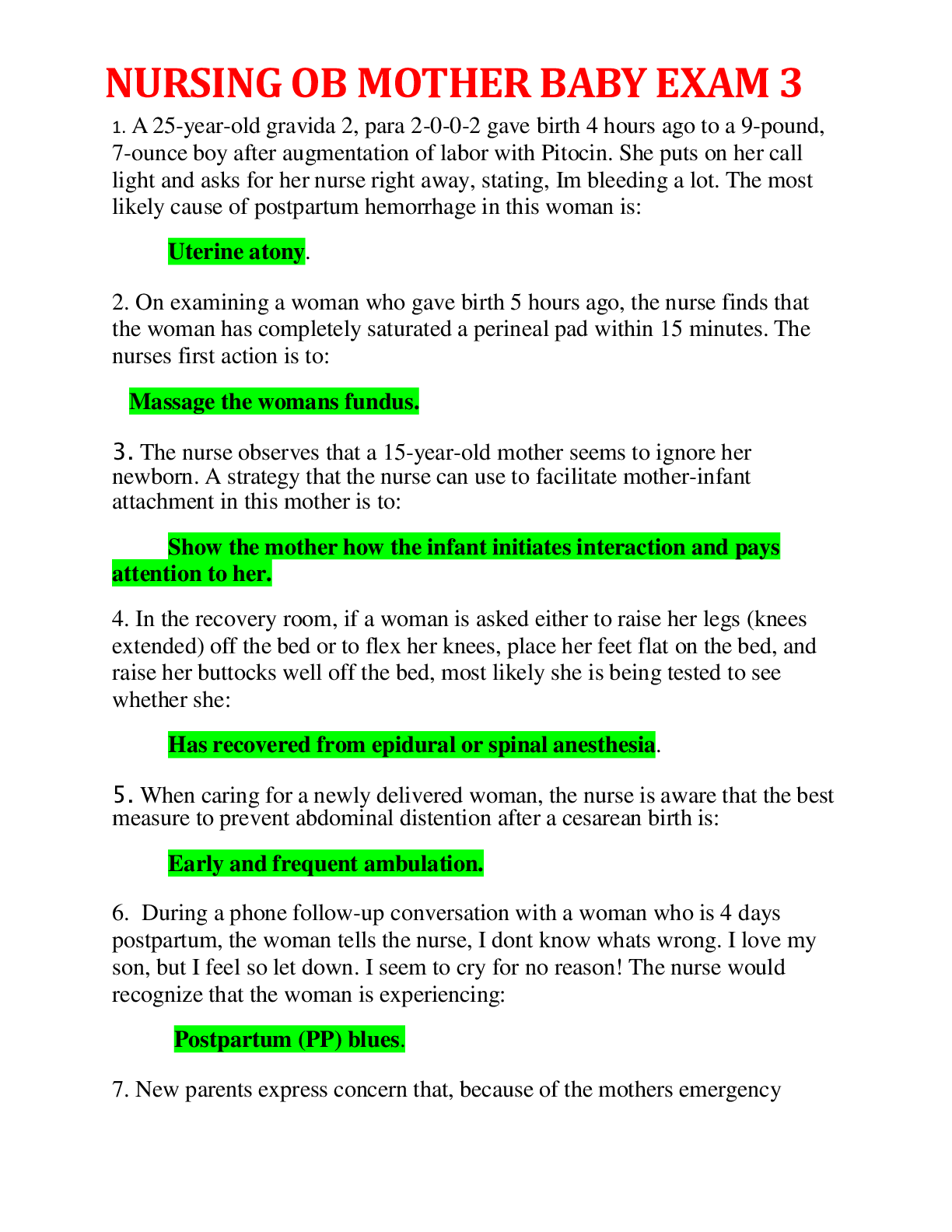
Buy this document to get the full access instantly
Instant Download Access after purchase
Buy NowInstant download
We Accept:

Reviews( 0 )
$11.00
Can't find what you want? Try our AI powered Search
Document information
Connected school, study & course
About the document
Uploaded On
Jul 02, 2021
Number of pages
13
Written in
Additional information
This document has been written for:
Uploaded
Jul 02, 2021
Downloads
0
Views
80

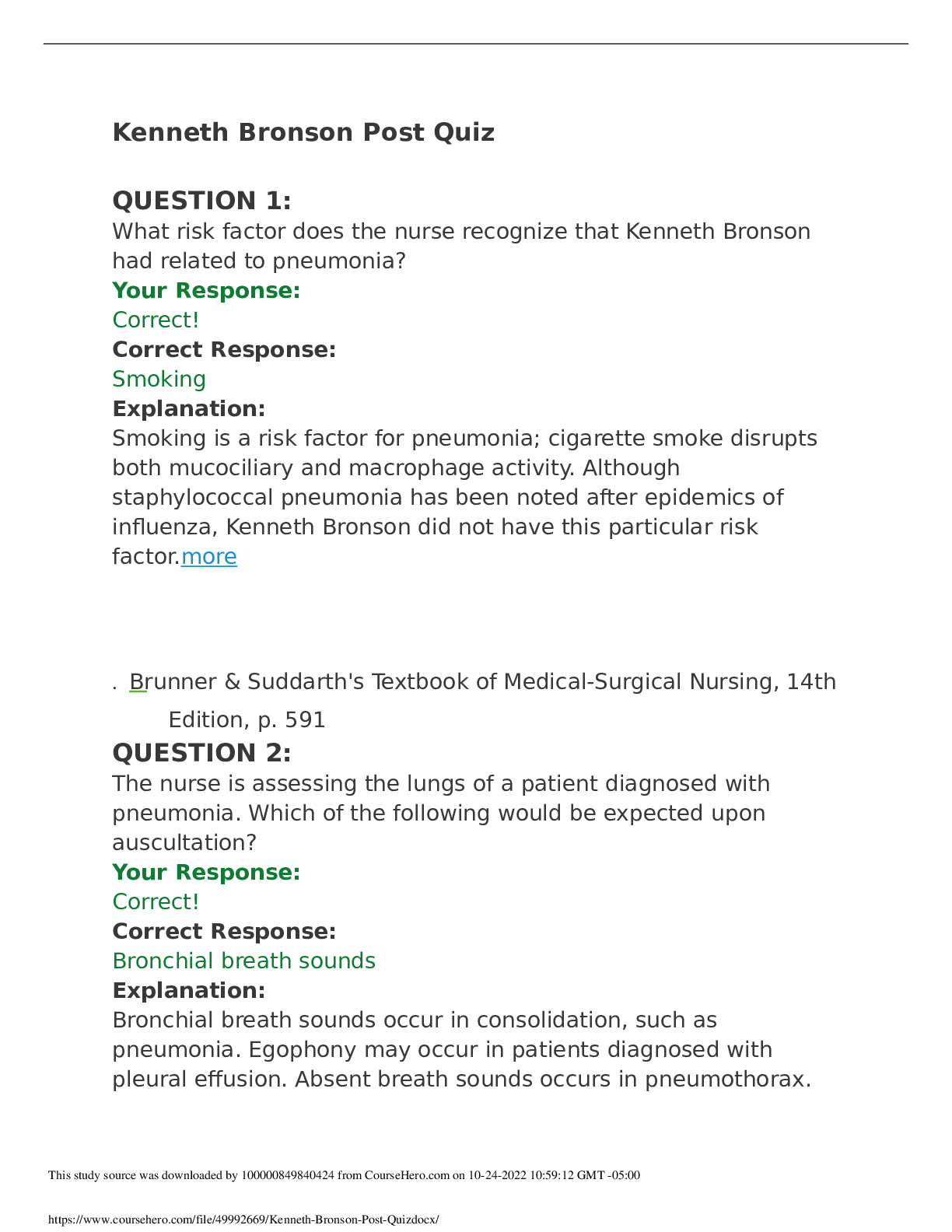



 Questions and Answers 100% VERIFIED.png)
 Questions and Answers 100% correct Solutions.png)



